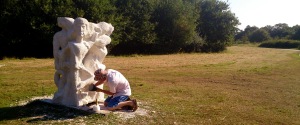The Pulborough stone which has been carved through 2013/4 at Wiggonholt approaches completion. It will be called Trisantonis, the Roman name meaning ‘the trespasser’, given to the middle Arun waters which regularly flooded and created the inland sea overlooked by Pulborough. Its improvised imagery has reverted to human form through both river goddess and ambiguous sword-cla d Roman with a supporting coterie of wetland birds. It is far from the designed works that are decreed for most public sculpture. That it exists and has taken this form is still another minor miracle to me.
d Roman with a supporting coterie of wetland birds. It is far from the designed works that are decreed for most public sculpture. That it exists and has taken this form is still another minor miracle to me.
Some have suggested that the sculpture should stay permanently in public view in the local area. There is already over a thousand pounds pledged towards something as yet unplanned.
Returning yesterday from Norfolk’s Hickling Broad, I realised we have stayed, intermittently, in the same waterside location for 35 years.  I pondered the thatched ’Studio’ across the water from the houseboat and discovered it had been home to Roland Green, an artist who had painted wildfowl from the top of a converted windpump looking out over the reedbeds. He was commissioned in 1929 to provide murals for a lodge further up the broad.
I pondered the thatched ’Studio’ across the water from the houseboat and discovered it had been home to Roland Green, an artist who had painted wildfowl from the top of a converted windpump looking out over the reedbeds. He was commissioned in 1929 to provide murals for a lodge further up the broad.
In 1908, three politicians (and later, members of the same Cabinet) Edward Grey, 1st Viscount Grey of Fallodon, Auberon (Bron) Herbert, 9th Baron Lucas and Edwin Montagu bought a section of Norfolk Broadland intending it to be a bird sanctuary. Grey and Lucas both attended Balliol and Grey had shot duck in the area in his youth. Bron Lucas latterly bought Heigham Sound, Horsey Mere and Hickling Broad, the latter coming with the small Whiteslea Lodge.
In 1916, Bron Lucas went missing over enemy lines. Whiteslea and the rest of his Norfolk Estate was inherited by Ivo Grenfell, the youngest son of Baron Desborough, another Balliol man. The family grew to love the place, but after Ivo was killed as a result of a car accident in 1926 (sad indeed after both his brothers died in the First World War), his father took on the Estate and with it responsibility for 3,000 acres of the Broads. Whiteslea Lodge was a modest single storey wooden building that provided a base for winter shooting parties that had involved both George V and George VI, visiting from Sandringham. In 1959, The Duke of Edinburgh stayed at Hickling’s Pleasure Boat Inn after flooding diverted their sojourn at Whiteslea; Prince Charles was allegedly reprimanded by the landlady Gwen Amis for having a pillow fight in his room.
The wildfowl at Hickling made these social occasions possible – a massive coot shoot continued until the 1950s.
Our waterfowl species were rich. Recent isotope composition analysis of Richard III’s gut remains showed his 15th century diet included regular Heron, Egret, Swan and Crane. But changing land-use and the growth in popularity of collecting and shooting led to gradual decline. Records at Birmingham Museums and Galleries Ornithological Collections show the Victorian Lysaght Collection having 1860 birds of 325 species, and Norfolk accounted for 73% of the total. Of the half with detailed records, Hickling provided about 10% of the specimens. Another facet to the collectors’ mentality is the story of Edward Thomas Booth (his huge collection now bequeathed to Brighton and Hove) who had raised fledgling gannets in pens behind his house to enable him to kill them when they reached the level of plumage required for his display.
A manuscript written by Lord Desborough (on Sandringham paper) entitled “The King/The Last 2 Shoots when I was there” gave the numbers of birds shot at Hickling on 16th August (408) and 19th September 1939 (307). It also noted “The shooting does not interfere with the bird sanctuary”. Desborough was Vice-President of the RSPB.
It is ironic that now-public Collections remind us of what we have lost, whilst famed former hunting haunts have helped conservation through the mobilisation of huge tracts of land through bequests and inheritance taxation mitigation. They now have a greater degree of protection through enhanced conservation status nationally and internationally. Re-populations occur, both assisted and naturally, where the gene pool was not obliterated.
All this wealth of bird life had just been ‘there’ whilst learning to sail on family holidays; I now realise the environment’s capacity to penetrate within, whilst watching my own son experiencing it. The emergent forms of the Pulborough sculpture must also link to Hickling and my formative years of becoming an observer.
My observations… have been intermittent. With watchers… some are attracted by one aspect and some by another. Thus, even those of us who have nothing new to tell, may have something that is fresh to say.
The Charm of Birds; Grey of Fallodon (1927) Hodder and Stoughton
A new sculpture will begin in late November 2014 at Slindon in Sussex, funded by the National Trust through a new bequest. The site of Northwood is the Trust’s largest woodland re-creation to date and the stone will hopefully be an observer of past, present – and future.
note: Norfolk Wildlife Trust – previously named Norfolk Naturalists Trust – now owns Whiteslea Lodge, Hickling.


